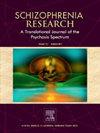The role of the behavioural inhibition and activation system in the association between attachment style and positive or negative symptoms in patients with psychosis and unaffected siblings
IF 3.6
2区 医学
Q1 PSYCHIATRY
引用次数: 0
Abstract
Background
The association between attachment style and psychotic symptomatology is well established. However, little is known about the mechanisms underlying this relationship. In the present study, we aimed to investigate whether the sensitivity of the behavioural inhibition and activation system mediates the association between attachment style and positive or negative symptoms, in patients with psychotic disorders and unaffected siblings.
Methods
In a subsample of the Genetic Risk and Outcome of Psychosis (GROUP) study (87 patients and 94 siblings), attachment style was assessed using the Psychotic Attachment Measure, behavioural inhibition or activation with the Behavioral Inhibition System (BIS) and Behavioral Activation System (BAS) Scale and positive and negative symptomatology with the Community Assessment of Psychic Experiences. Linear regression models and mediation models were used, while correcting for age and gender and adjusting for multiple testing.
Results
We found that anxious and avoidant attachment were associated with negative symptoms across both groups. Additionally, in siblings, anxious and avoidant attachment were associated with positive symptoms. In the patient group, BIS sensitivity mediated the association between anxious attachment and negative symptoms. In the sibling group, BIS sensitivity mediated the association between avoidant attachment and both positive and negative symptoms, and between anxious attachment and positive symptoms.
Conclusions
Findings indicate that BIS sensitivity, but not BAS sensitivity, is a possible mediating mechanism contributing to the association between insecure attachment and psychotic symptoms. Longitudinal studies are required to confirm the associations between attachment style, BIS and BAS sensitivity, and psychotic symptoms, and explore causality.
求助全文
约1分钟内获得全文
求助全文
来源期刊

Schizophrenia Research
医学-精神病学
CiteScore
7.50
自引率
8.90%
发文量
429
审稿时长
10.2 weeks
期刊介绍:
As official journal of the Schizophrenia International Research Society (SIRS) Schizophrenia Research is THE journal of choice for international researchers and clinicians to share their work with the global schizophrenia research community. More than 6000 institutes have online or print (or both) access to this journal - the largest specialist journal in the field, with the largest readership!
Schizophrenia Research''s time to first decision is as fast as 6 weeks and its publishing speed is as fast as 4 weeks until online publication (corrected proof/Article in Press) after acceptance and 14 weeks from acceptance until publication in a printed issue.
The journal publishes novel papers that really contribute to understanding the biology and treatment of schizophrenic disorders; Schizophrenia Research brings together biological, clinical and psychological research in order to stimulate the synthesis of findings from all disciplines involved in improving patient outcomes in schizophrenia.
 求助内容:
求助内容: 应助结果提醒方式:
应助结果提醒方式:


